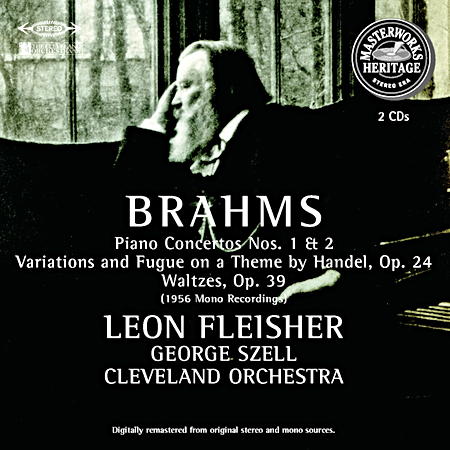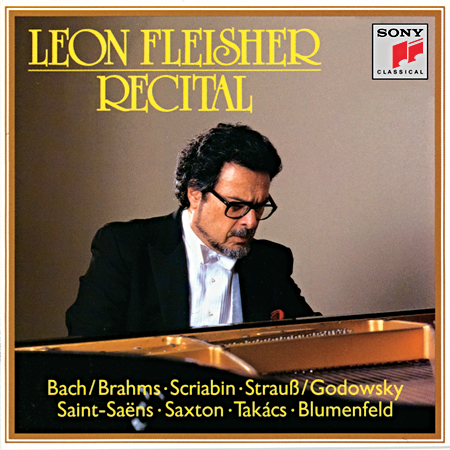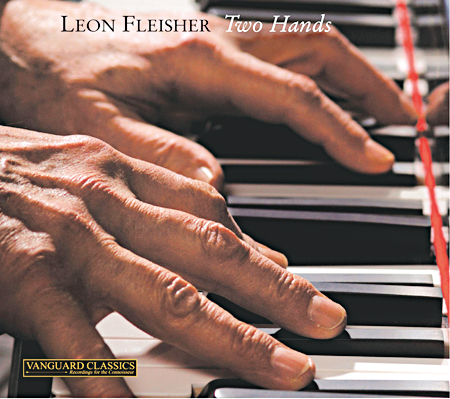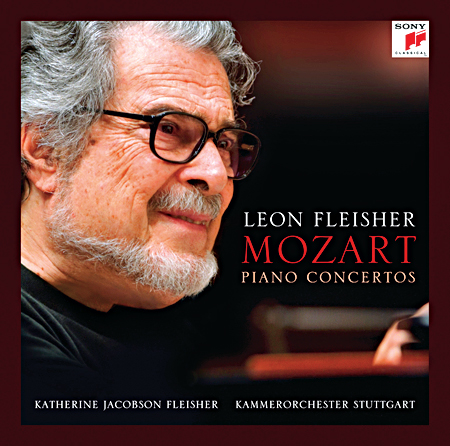Leon Fleisher
The heroic pianist reflects on his discography.
By Bradley Bambarger
Pianist leon fleisher has one of the great comeback stories in classical music. Born in 1928 in San Francisco, Fleisher studied with golden-age piano icon Artur Schnabel and made a grand concerto debut at age 16 with the New York Philharmonic under Pierre Monteux. By the mid-’60s, he was a high-profile virtuoso who made a celebrated series of recordings with George Szell and the Cleveland Orchestra—Beethoven, Brahms, Schumann, Grieg, Mozart, Franck, Rachmaninoff. l But the pianist developed focal dystonia, a neurological movement disorder; it left him unable to play with his right hand for 30 years. Fleisher was forced to focus on teaching and conducting, as well as performing the repertoire for left hand alone; this he did as a master, but his was a career truncated.
Yet after decades of unsuccessful therapies, Botox injections began to restore the use of Fleisher’s right hand in the early ’90s. Successful concert performances of Mozart concertos gradually led to 2004’s acclaimed Two Hands, his first solo recording in more than 40 years; the album also lent its title to an Oscar–nominated short documentary on his recovery. Fleisher’s solo follow-up, The Journey, came in 2006; a new album of Mozart concertos is his comeback’s latest fruit.
As a man who has experienced life’s vicissitudes, Fleisher has a gruffly Zen equanimity about any laurels. But, reached at home in Baltimore (where he has taught at the Peabody Conservatory since 1959), the pianist indulged us by recollecting some highlights of his recording career. Fleisher protested at first that his memory would be hazy just chatting about old records. But the reminiscences unfolded as easily as if he were leafing through a photo album, his commentary on music characteristically acute as he warmed to the task.

Beethoven: Piano Concertos Nos. 1–5 Brahms: Piano Concertos Nos. 1 and 2 The Cleveland Orchestra; George Szell, conductor (Columbia, 1957–63)
Fleisher’s Beethoven and Brahms concerto recordings became instant classics. The prize-winning up-and-comer was drafted to work with the most rigorous of old-school conductors: the Hungarian–born George Szell. As a virtuoso martinet, it was Szell who made the Cleveland Orchestra into a precision recording instrument, its new, improved Old World sound an ideal complement to Fleisher’s youthful brio.
“The atmosphere for the Beethoven and Brahms sessions was highly charged, but then everything was with Szell. His demands were very high, his standards usually way above everyone else’s. The difficulty, if there was any, was he felt that anyone he agreed to work with should adhere automatically to his standards. If that didn’t happen, he became testy. You couldn’t blame him, really. The Cleveland Orchestra had enormous respect for him. And he craved respect, not love. He wasn’t Leonard Bernstein.
“But Szell could be open. I remember when recording Beethoven’s B-flat Concerto [#2], which has a long opening tutti, Szell told the producer up in the booth, Howard Scott, that he wasn’t happy with the take and wanted to do it again. So, Szell did it a second time and stopped again, holding his hand out and keeping me from coming in. He still wasn’t happy, and that was making Howard antsy, as it was an expensive process. I could tell what was bothering Szell; it seemed a little heavy-footed. So I went up to him and asked, ‘What if you asked for it to be a little more debonair?’ That seemed to strike a note with him, so he turned and asked for it to be a little more debonair—and that was it. When you hear it, it sounds a bit like Charlie Chaplin walking down the Champs-Élysées.
“The Cleveland players were very quick. That is the measure of any instrumentalist’s technique. It’s not a question of playing faster or louder than anybody else; it’s the ability to immediately produce the effect you want. If you can’t do it immediately, that indicates a lack of technique. The Clevelanders could do it collectively.
“But we were all in another zone for these sessions, another dimension . . . I was able to do pretty much what I was aiming to do. There is a certain vitality and spontaneity there that I was going for and that Szell was going for, too. I don’t ever just put one of these recordings on, but if I happen to hear one of them on the radio by accident, I do find it pleasing.”
“If you can’t do it immediately,
that indicates a lack of technique.”

Ravel: Piano Concerto for the Left Hand
The Baltimore Symphony; Sergiu Comissiona, conductor (Vanguard, 1982)
Pianist Paul Wittgenstein lost his right arm in World War I, but used capital from his well-off industrialist family to commission a series of left-hand concertos from top composers — from Hindemith, Prokofiev and Ravel to Schmidt, Korngold and Britten. The one that became standard repertoire is Ravel’s Piano Concerto for the Left Hand.
“The Ravel recording in Baltimore was in a hall that was less than we could have hoped for, acoustically. But it was a good experience, the orchestra totally up for it. And Sergiu Comissiona was a wonderful musical compatriot. He was so expressive physically, without undue exaggeration; he was able to convey all sorts of subtleties through his posture and attitude. Comissiona was a totally different animal from Szell. He was very warm, a great sense of humor; he put the orchestra at ease. But Comissiona also had high standards, and he really built up the Baltimore Symphony.
“Before the recording, I didn’t really know the Ravel Left-Hand. When I was playing with two hands, it had never occurred to me to learn the piece. But when it came time to admit that I couldn’t play that way anymore, I delved into the left-hand repertoire—and discovered to my extraordinary satisfaction that the Ravel is one of the great masterpieces of the concerto literature, period. It’s so magnificently composed and orchestrated. Ravel said one of his goals was that if someone listened to the work with eyes closed that he would perceive nothing amiss, that it would never occur to the listener that there were only five fingers playing. And that is the effect, absolutely.
 Recital: Works for the Left Hand Solo pieces by Bach-Brahms, Saint-Saëns, Scriabin, Godowsky, Blumenfeld, Saxton and Takacs (Sony Classical, 1993)
Recital: Works for the Left Hand Solo pieces by Bach-Brahms, Saint-Saëns, Scriabin, Godowsky, Blumenfeld, Saxton and Takacs (Sony Classical, 1993)
Fleisher again made a virtue of necessity when he explored his favorite works from the left-hand solo repertoire. The Brahms transcription of Bach’s mighty Chaconne, originally from his D Minor Partita for solo violin, is a highlight.
“Unlike the Busoni version of Bach’s Chaconne, the Brahms is pure Bach, not a note added or subtracted. He only put it down an octave for sonic reasons, so that everything wasn’t so high in the treble. Busoni’s purpose was to elaborate on Bach’s work; to me, the Chaconne hardly needs to be elaborated upon—it is a monolithic monument. All that elaboration just adulterates it. But moving it from violin to piano doesn’t matter: Bach’s music is abstract; you can play him on the kazoo, and it still sounds great. Brahms made his transcription for Clara Schumann, Robert Schumann’s wife, who was a famous concert pianist and his dear friend. She had hurt her right hand and needed to rest it. He made the Bach transcription to keep her off the streets, I suppose.
“Scriabin wrote two beautiful pieces, a Prelude and a Nocturne, for left hand alone. He had hurt his right hand at the time. Scriabin’s music doesn’t sustain itself over long periods for me; in small doses, though, it’s quite powerful. Lukas Foss once said, ‘Give a composer limits, and it stimulates their creative juices.’ But there isn’t any real literature for the right hand alone. It has to do with the biomechanics of the left hand and the layout of the keyboard, where you can play bass line and harmony with four fingers and tap out the melody with the thumb. You can’t play harmony and bass line with the thumb of the right hand.”
 Two Hands Solo pieces by Bach, Scarlatti, Chopin, Schubert and Debussy (Artemis, 2004)
Two Hands Solo pieces by Bach, Scarlatti, Chopin, Schubert and Debussy (Artemis, 2004)
For his first two-hand solo recording in four decades, Fleisher chose two chorales by Bach (“mantra music”), a Scarlatti sonata (which he played spontaneously just to check the piano for the sessions), a sequence of “night music” (Chopin and Debussy) and Schubert’s B-flat Major Sonata, D. 950, the work he recorded for his Columbia solo debut nearly a half-century before. His second recording of Schubert’s final sonata ranks among the most poetic ever made.
“After I regained use of my right hand and had played some concerts with orchestra, I found a group of solo pieces that I could play reasonably well, but also that had special meaning for me. The D-flat Chopin Nocturne was my mother’s favorite, so that had to be on there. I wanted to match it with another night piece, so Debussy’s ‘Clair de Lune’ felt natural, and both are in the same key. Then there are what I call ‘triple-A’ pieces—anthems for anti-acrimony—Bach’s ‘Sheep May Safely Graze’ and ‘Jesu, Joy of Man’s Desiring.’ And the Schubert D. 950 is sublime, incredibly moving. One of the characteristics of Schubert is that his major-key tunes are often infinitely sadder than his minor-key tunes. He was able to summon this quality of recollection, of remembrance, a kind of looking over your shoulder at what has been. But that doesn’t begin to do justice to the feeling of the music; there are probably no words that do it justice.”
“My approach to Mozart isn’t the
same as it was a half-century ago — at least I hope to God not.”
 Mozart: Piano Concertos K. 414, K. 488, K. 242 Stuttgart Chamber Orchestra (Sony-BMG Masterworks, 2009)
Mozart: Piano Concertos K. 414, K. 488, K. 242 Stuttgart Chamber Orchestra (Sony-BMG Masterworks, 2009)
Fleisher recorded a Mozart concerto with Szell and the Cleveland Orchestra in the late ’50s, and he returned to his two-hand concert life with the Clevelanders in 1995 playing a Mozart concerto: No. 12 (K. 414). He has featured the K. 414 on his first two-hand concerto recording since the ’60s, an all-Mozart disc. Leading one of his favored groups in recent years, the Stuttgart Chamber Orchestra, Fleisher also includes the later A Major Concerto (No. 23, K. 488) and the Concerto for Two Pianos in F Major (K. 242) with his wife, Katherine Jacobson-Fleisher, as partner.
“My approach to Mozart isn’t the same as it was a half-century ago—at least I hope to God not. Music is a living art. You hear new connections, new relationships; some aspects become more important, others less so. But it’s impossible to encompass everything a great piece of music has to say in one performance because it has so many refractions. You pick and choose, but you’re playing for the moment, really. A recording is just a frozen moment.”
This article originally appeared in Listen: Life with Music & Culture, Steinway & Sons’ award-winning magazine.